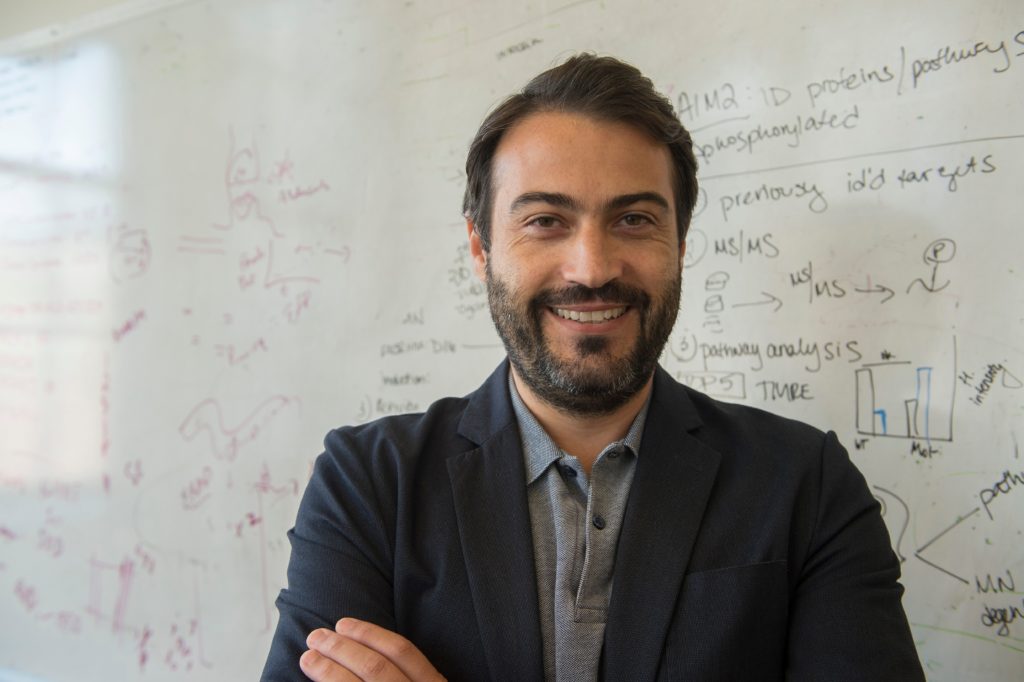
Northwestern Medicine investigators have uncovered how a genetic variant linked to ALS disrupts neuronal function in a new study published in Science Advances.
Amyotrophic lateral sclerosis (ALS) progressively weakens the muscles we use to move, swallow and breathe, eventually leading to death. The symptoms and progression of ALS vary from person to person, which can make the disease difficult to diagnose, manage and treat.
Two to three percent of all ALS cases are caused by a mutation in the gene NEK1, but exactly how the mutation affects motor function is still unclear, said Evangelos Kiskinis, PhD, assistant professor in the Ken and Ruth Davee Department of Neurology’s Division of Neuromuscular Disease and of Neuroscience and senior author of the study.
In the current study, investigators first conducted a proteomics analysis of NEK1 in human motor neurons using mass spectrometry, finding that proteins produced by NEK1 interact with two additional proteins known to be essential in nucleocytoplasmic transport and microtubule homeostasis, TUB1AB and KPNB1.
When scientists reduced the amount of NEK1 in human motor neurons, it disrupted the function of the microtubules, which are essential components of the cell skeleton and determine its shape. A reduction in NEK1 also disturbed the import of cellular cargo into the nucleus.

“ALS-causing mutations in the NEK1 gene were identified in 2015, but how this gene causes disease has remained relatively unexplored since then,” said Elizabeth McKenna, ’22 PhD, a graduate from the Interdepartmental Neuroscience (NUIN) program and former scientist in the Kiskinis laboratory who was a co-first author in the study. “We identified several proteins implicated in NEK1 function, which are also known to function in the microtubule cytoskeleton and the nucleocytoplasmic transport pathways, leading us to investigate those pathways more closely.”
Next, Kiskinis and his collaborators analyzed motor neurons from ALS patients who had an NEK1 mutation and observed similar disturbances in microtubule formation and cellular import processes.
By introducing anti-cancer drugs such as paclitaxel that are known to stabilize microtubules within cells, scientists were able to restore normal cellular import, according to the study.
Taken together, the results of the study point to NEK1 as a potential future therapeutic target for ALS, Kiskinis said.
“For the first time, we have characterized the impact of NEK1 loss of function, enzymatic inhibition as well as ALS associated in human motor neurons derived from stem cells,” Kiskinis said. “We found that NEK1 compromises nuclear import and microtubule homeostasis, two pathways previously implicated in other forms of ALS. The capacity of NEK1 to modulate these neuronal processes that are critically involved in ALS pathophysiology renders this kinase a formidable therapeutic candidate.”

The findings will also add to the known biomarkers for ALS, Kiskinis said.
In the future, investigators will continue to study NEK1 to better understand the impacts of mutations in the gene.
“While we did discover evidence that these two pathways may be regulated by direct NEK1-mediated phosphorylation, we have yet to define the precise mechanisms linking NEK1 loss-of-function to disruption of microtubule homeostasis and nuclear import,” said Jacob Mann, PhD, a postdoctoral fellow in the Kiskinis laboratory and first author of the study.
“Our future studies are aimed at addressing these questions, in the hopes that we can uncover specific molecular events that are dysregulated in NEK1-ALS and may be targeted therapeutically to help guard against neurodegeneration.”
The study was supported by National Institute of Neurological Disorders and Stroke grants R01NS104219 and R21NS107761, the Les Turner ALS Foundation, the Healey Center for ALS at Massachusetts General Hospital ALS Scholars in Therapeutics Fellowship and the New York Stem Cell Foundation.






